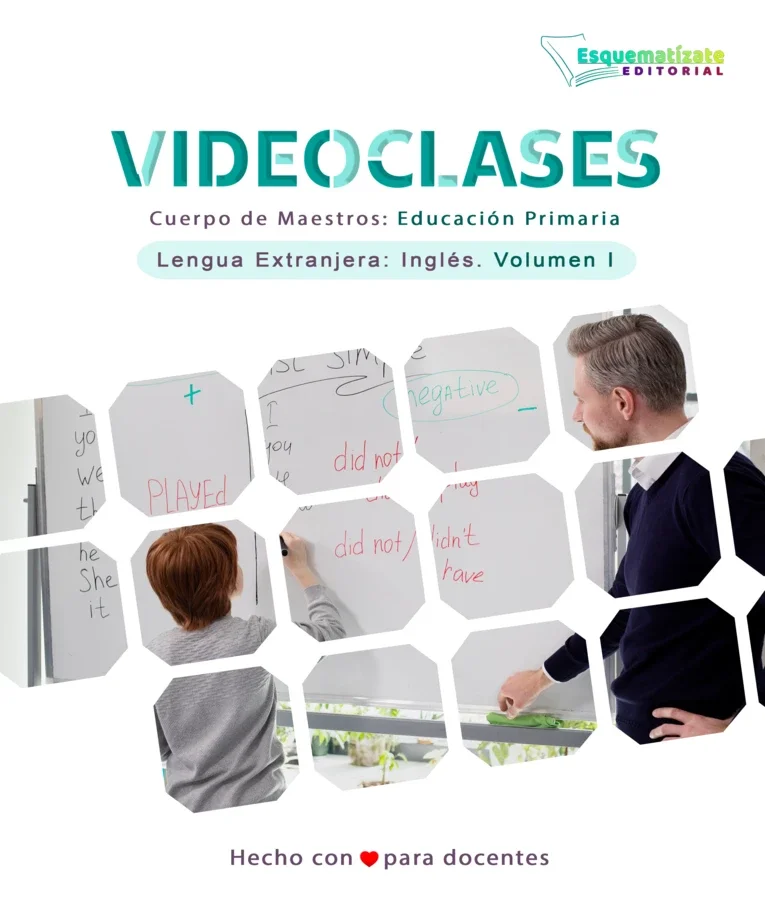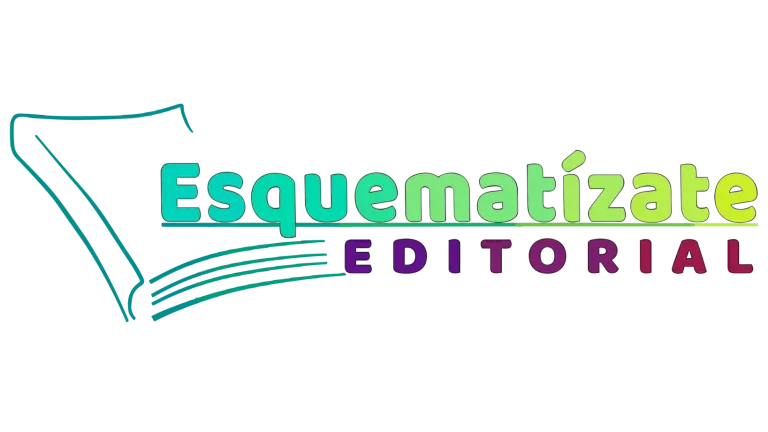videoclases Lengua extranjera inglés
¡EL NETFLIX DE LA OPOSICIóN DE EDUCACIÓN!

Fáciles de aprender

En base al temario de resúmenes

Profundidad científica

En base a los criterios de evaluación

Elaborados en base a la LOMLOE

Directas al grano, 20-30 minutos

Repasa el tema las veces necesarias

Videoclases muy didácticas


videoclases lengua extranjera inglés
VOLUMEN I
Videoclases del temario resumido de Lengua Extranjera Inglés, temas volumen I (del 1 al 13).
- Theories and models of communication: from language to communication
- Development of Roman Jakobson’s model
- Perspective of language by Michael Halliday
- Neil Mercer’s theory
- Jakobson’s functions and Bühler’s functions
- The importance of oral and written language in the classroom
- The sender and the receiver: roles and responsibilities in the communicative process
- The functionality of language: practical and strategic use in the classroom
- Context: a determining factor in communication
- Strategies for effective English language teaching based on communication
- Sociocultural Interaction: a critical element in English language teaching
- Conclusion
- Bibliography
- Conceptualization of communication in the foreign language class
- The importance of verbal communication in language teaching
- The relevance of non-verbal communication in foreign language education
- Extralinguistic strategies in the teaching of foreign languages
- Non-verbal reactions to messages in different contexts
- The importance of feedback in the learning process
- The integration of technologies in the class of foreign languages
- Conclusion
- Bibliography
- Development of listening comprehension
- Development of the oral expression
- Development of written comprehension
- Development of written expression
- Development of the communicative competence in English
- Integration of language skills: speaking, listening, reading and writing
- Conclusion
- Bibliography
- Importance of foreign languages in the globalized society
- Linguistic diversity: source of wealth and learning
- Foreign language learning and the promotion of global peace
- The role of education in the assessment of knowledge of foreign languages
- Teaching strategies to foster appreciation of linguistic and cultural diversity
- Benefits of learning foreign languages
- Practical cases of how knowledge of foreign languages has fostered communication and intercultural understanding
- Conclusion
- Bibliography
- Location and physical characteristics
- Weather and weather patterns
- Historical overview of English-speaking countries
- Cultural development
- Political changes
- Cultural panorama of English-speaking countries
- Religion
- Holidays and traditions
- Cooking and gastronomy
- Didactic application of the most significant geographical, historical, and cultural aspects
- Conclusion
- Bibliography
- Linguistics: the foundation of the teaching of foreign languages
- The language learning process: a continuous journey
- Similarities between first language and foreign language acquisition
- Differences between first language and foreign language acquisition
- Use of linguistics in pedagogical strategies for the teaching of foreign languages
- Comparative linguistics: establishing links between the mother language and the foreign language
- Challenges and opportunities in the teaching of foreign languages
- Summary of practical cases: applying linguistics in the foreign language classroom
- Conclusion
- Bibliography
- The role of listening in oral comprehension
- The role of active listening in understanding oral interactions
- The role of selective listening in understanding oral interactions
- Advantages of developing oral communication in a foreign language
- Strategies to increase listening skills in a foreign language
- Take the floor: from imitative reproduction to autonomous production
- Conclusion
- Bibliography
- Importance of the written foreign language in primary education
- Approach to the reading and writing process in the foreign language
- Development of reading skills in the foreign language: from decoding to global comprehension
- Techniques for specific comprehension of texts in the foreign language
- Development of writing skills in the foreign language: from interpretation to the production of texts
- Assessment of written proficiency in the foreign language
- Conclusion
- Bibliography
- Phonological system of the English language
- Phonetic learning models and techniques
- Phonetic correction and feedback
- Perception of English sounds
- Discrimination of English sounds
- Emission of English sounds
- Rhythms of the English language
- Conclusion
- Bibliography
- The relationship between sound and spelling
- Features of the English spelling system
- Didactic proposals to teach the written code in English
- Applications of spelling in written productions
- Assessment of spelling proficiency in English
- Integration of spelling in the English curriculum
- Resources and didactic materials for teaching spelling in English
- Development of self-correcting and revision strategies in English spelling
- Conclusion
- Bibliography
- Lexical and semantic fields in English: theoretical and scientific foundations
- Strategies for teaching and learning lexical and semantic fields in English
- Assessment of lexical development in English
- Use of the vocabulary in oral and written productions
- The lexicon in reading and writing activities
- Use of technology for learning and practicing vocabulary
- Metalinguistic awareness in the lexicon learning
- Conclusion
- Bibliography
- Theoretical foundations of morphosyntax in the English language
- Basic sentence structure in English: subject and predicate
- Grammatical categories
- The importance of adjectives and adverbs in precise and detailed expression
- The role of verbs and tenses in the construction of meaning
- Prepositions and their function in the spatial and temporal relationship
- The proper use of conjunctions to connect ideas and sentences
- Strategies for the development of morphosyntax in oral and written productions
- Conclusion
- Bibliography
- Overview of the grammatical-translational method
- The emergence of the audio-linguistic method
- Communicative Language Teaching
- Total Physical Response
- Task-Based Language Teaching
- Content and Language Integrated Learning
- Current trends in language teaching
- Conclusion
- Bibliography
Editorial: ESQUEMATÍZATE EDITORIAL
Nivel: Preparación de Oposiciones.
Cuerpo: Cuerpo de Maestros.
Especialidad: Lengua Extranjera Inglés.
Idioma: Inglés.
La suscripción mensual se renueva automáticamente hasta que se cancele.
Tanto si tienes alguna duda como si deseas comprarlo, escríbenos por WhatsApp para confirmarte disponibilidad (atención 24/7).
Los pedidos de libros de resúmenes y esquemas no admiten devolución.
Videoclases Temario Vol. 1
Temas 1-13
45,00 € / mes
Métodos de pago aceptados:
Aquí tienes una muestra de lo que verás en el volumen I


videoclases lengua extranjera inglés
VOLUMEN II
Videoclases del temario resumido de Lengua Extranjera Inglés, temas volumen II (del 14 al 25).
- Communicative approaches in teaching English
- Development of linguistic competence in English as a foreign language
- Integration of language skills: speaking, listening, reading, and writing
- Use of teaching materials and resources in teaching English
- Assessment of communication skills in English
- Integration of culture and interculturality in the teaching of English
- Teacher professional development in teaching English
- Promotion of motivation and love for learning English
- Conclusion
- Bibliography
- Classical literature
- Romantic literature
- Modern literature
- Popular authors and Works
- Poetry
- Drama
- Fiction
- Non-fiction
- Conclusion
- Bibliography
- Importance of oral comprehension in teaching children’s literature
- Didactic techniques to develop oral comprehension in children’s literature
- Strategies to initiate and enhance reading habits in students
- Sensitization to the poetic function of language in children’s literature
- Children’s literature in the English language curriculum and didactic application
- Conclusion
- Bibliography
- Background and cognitive theories behind the use of music in education
- Characteristics of songs as a didactic tool
- Typology of songs used in the English class
- Song techniques for lexical and grammar learning
- The song as a tool for cultural learning
- Evaluation and reflection on the use of the song in the English classroom
- The creative integration of the song in the English class
- Conclusion
- Bibliography
- Educational and psychological theories on play and creativity in language learning
- Characteristics of the game in language education
- Definition and typology of games for language learning
- The role of play in the development of language skills
- Access to communicative competence through games
- The game as a ludic-creative technique for learning foreign languages
- Creation of a classroom environment that favors play and creativity
- Tools and resources for play and creativity in language teaching
- Evaluation of the effectiveness of the game and creativity in learning foreign languages
- Challenges and solutions in the implementation of the game and creativity in the teaching of foreign languages
- Conclusion
- Bibliography
- Benefits of animation and expression techniques for language learning
- Dramatization of everyday life situations in the foreign language class
- Representation of stories, characters and jokes in language learning
- Group work for creative activities in foreign language learning
- The role of the teacher in the ludic-creative techniques
- Conclusion
- Bibliography
- Importance of foreign languages in current education
- Objectives and competences in the teaching of foreign languages
- Methodological approaches in the teaching of foreign languages
- Criteria for the inclusion of foreign languages in the Educational Project of the Center
- Development of a foreign language curricular Project
- Factors to consider in the implementation of the foreign language curricular Project
- Conclusion
- Bibliography
- Didactic units in the teaching of foreign languages
- Criteria for sequencing contents in foreign languages
- Selection of methodology for learning activities
- Selection of methodology for the evaluation in the teaching of foreign languages
- Implementation and review of syllabus in foreign languages
- Conclusion
- Bibliography
- Student grouping
- Distribution of space and time
- Selection of methodologies
- The role of the teacher
- The role of assessment in the English language class
- Active learning
- Technologies in the English language class
- Interculturality and communicative competence in the English language class
- Conclusion
- Bibliography
- Authentic documents: their importance and limitations
- Adapted documents: their role in personalizing learning
- Student collaboration in material design
- Evaluation of the curricular materials of the English class
- Updating and continuous improvement of the curricular materials of the English class
- Conclusion
- Bibliography
- Technological and pedagogical aspects of the use of audiovisual materials
- Types of audiovisual materials for teaching foreign languages
- The computer as an auxiliary resource in learning foreign languages
- Selection and adaptation of audiovisual materials for different levels and learning objectives
- Didactic strategies for the effective integration of audiovisual materials in English classes
- Ethical and responsible aspects in the use of audiovisual materials and the computer in the English classroom
- Conclusion
- Bibliography
- Student-centered approach in foreign language teaching
- Motivation in learning English: importance and influencing factors
- Attitudes towards the English language: how to identify and address them in the classroom
- Strategies to arouse the interest and active participation of students in the English class
- Adaptation of the curriculum and learning activities to the student-centered approach
- Formative evaluation and feedback in the student-centered teaching-learning process
- Collaborative learning and group work
- The integration of new technologies in the student-centered approach
- Practical experiences and examples of applications of the student-centered approach in the English class
- Conclusion
- Bibliography
Editorial: ESQUEMATÍZATE EDITORIAL
Nivel: Preparación de Oposiciones.
Cuerpo: Cuerpo de Maestros.
Especialidad: Lengua Extranjera Inglés.
Idioma: Inglés.
La suscripción mensual se renueva automáticamente hasta que se cancele.
Tanto si tienes alguna duda como si deseas comprarlo, escríbenos por WhatsApp para confirmarte disponibilidad (atención 24/7).
Los pedidos de libros de resúmenes y esquemas no admiten devolución.
Videoclases Temario Vol. 2
Temas 14-25
45,00 € / mes
Métodos de pago aceptados:
Aquí tienes una muestra de lo que verás en el volumen II



¡O compra el Paquete completo de videoclases lengua extranjera inglés!
videoclases del Temario Volumen I y Volumen II
Videoclases
Temarios Vol. 1 y 2
Temas 1 – 25
90,00 € / mes
Métodos de pago aceptados:

